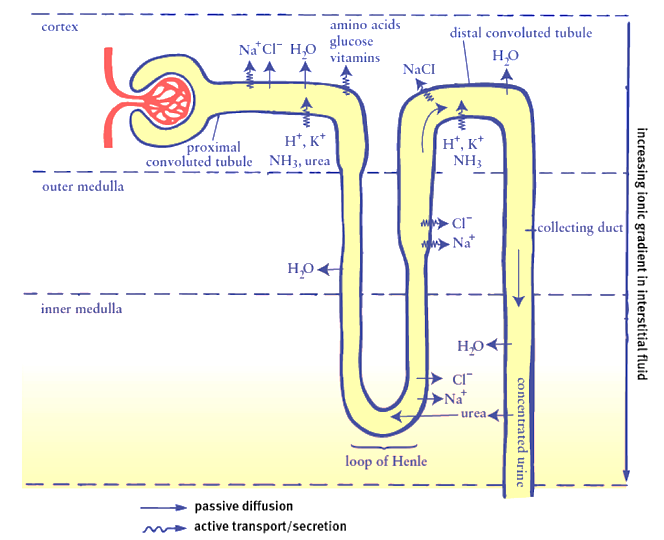
The part of nephron involved in active reabsorption of sodium is
A. Bowman’s capsule
B. Descending limb of Henle’s loop
C. Distal convoluted tubule
D. Proximal convoluted tubule
Answer
548.7k+ views
Hint:Nephron is the structural and functional unit of the kidney. Sodium-ion is a very important mineral that helps to maintain the concentration of blood. One of the major roles is played by sodium ions during urine formation. So, it needs to be reabsorbed in the nephron.
Complete answer:
Sodium reabsorption occurs through the tubules that are present in the nephron – proximal convoluted tubules or PCT and distal convoluted tubules or DCT.
The proximal convoluted tubule or PCT helps in the active reabsorption of sodium ions. It helps to reabsorb the sodium from the urine into the peritubular capillary network and passive flow of water is seen here.
In proximal convoluted tubules, almost 67% sodium ion reabsorption takes place.
In the distal convoluted tubule of the nephron, sodium ion reabsorption occurs but only under hormonal regulation which is a conditional response of the nephron to the environment of the body.
So, the correct answer is option D. Proximal convoluted tubule.
 Fig: Nephron and renal tubular reabsorption across different parts of the nephron
Fig: Nephron and renal tubular reabsorption across different parts of the nephron
Note: Besides sodium ions, potassium ions, calcium ions, bicarbonate ions, chloride ions, water, glucose, urea, uric acid, proteins vitamins, amino acids are also reabsorbed by PCT. In the DCT sodium ion, chloride ion, bicarbonate ion, and water take place under special conditions. In the loop of Henle, a counter-current mechanism of absorption of sodium ions, chloride ions, potassium ions, urea, and water takes place.
Complete answer:
Sodium reabsorption occurs through the tubules that are present in the nephron – proximal convoluted tubules or PCT and distal convoluted tubules or DCT.
The proximal convoluted tubule or PCT helps in the active reabsorption of sodium ions. It helps to reabsorb the sodium from the urine into the peritubular capillary network and passive flow of water is seen here.
In proximal convoluted tubules, almost 67% sodium ion reabsorption takes place.
In the distal convoluted tubule of the nephron, sodium ion reabsorption occurs but only under hormonal regulation which is a conditional response of the nephron to the environment of the body.
So, the correct answer is option D. Proximal convoluted tubule.

Note: Besides sodium ions, potassium ions, calcium ions, bicarbonate ions, chloride ions, water, glucose, urea, uric acid, proteins vitamins, amino acids are also reabsorbed by PCT. In the DCT sodium ion, chloride ion, bicarbonate ion, and water take place under special conditions. In the loop of Henle, a counter-current mechanism of absorption of sodium ions, chloride ions, potassium ions, urea, and water takes place.
Recently Updated Pages
Why are manures considered better than fertilizers class 11 biology CBSE

Find the coordinates of the midpoint of the line segment class 11 maths CBSE

Distinguish between static friction limiting friction class 11 physics CBSE

The Chairman of the constituent Assembly was A Jawaharlal class 11 social science CBSE

The first National Commission on Labour NCL submitted class 11 social science CBSE

Number of all subshell of n + l 7 is A 4 B 5 C 6 D class 11 chemistry CBSE

Trending doubts
1 Quintal is equal to a 110 kg b 10 kg c 100kg d 1000 class 11 physics CBSE

What is Environment class 11 chemistry CBSE

Bond order ofO2 O2+ O2 and O22 is in order A O2 langle class 11 chemistry CBSE

How many squares are there in a chess board A 1296 class 11 maths CBSE

Distinguish between verbal and nonverbal communica class 11 english CBSE

The equivalent weight of Mohrs salt FeSO4 NH42SO4 6H2O class 11 chemistry CBSE




